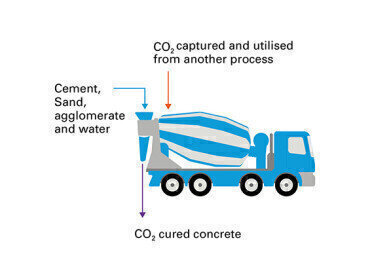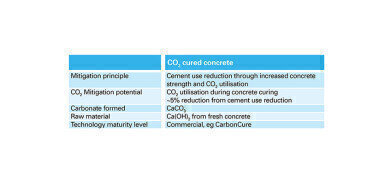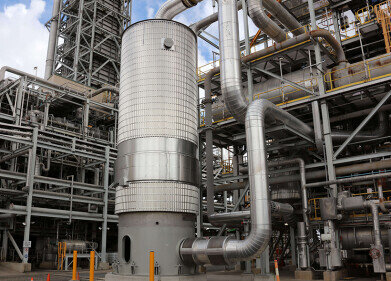-
 Mineralisation processes for CO2 emissions reduction in cement making and concrete production
Mineralisation processes for CO2 emissions reduction in cement making and concrete production -
 Mineralisation processes for CO2 emissions reduction in cement making and concrete production
Mineralisation processes for CO2 emissions reduction in cement making and concrete production
Air Clean Up
Carbon Dioxide clean-up by means of mineralisation
Jun 16 2021
Author credit – Stephen B. Harrison, Managing Director, sbh4 consulting
Weathering is a natural process where rocks, and minerals are breaking down as they are exposed to water and atmospheric gases. If carbon dioxide from the atmosphere is dissolved in water, carbonic acid is formed. The aqueous solution of carbon dioxide causes weathering of primary minerals into secondary carbonate minerals which is referred to as carbonation.
The overall speed of the process is very slow, and mainly depends on local temperature, pressure, permeability, and the relative strength of the original rock formation. Primary minerals like Olivine, a weak basalt rock with the chemical formula (Mg, Fe)2SiO4, weather in nature quite quickly under the right conditions.
To store CO2 in a carbonate form, a raw material with a high metal oxide or metal hydroxide content is required. One example is cured Portland cement which has a distinctive calcium hydroxide fraction. Whereas other raw materials are fly ash (CaO 10-40%, MgO 0-10%) and steel slag (CaO 40-50%, MgO 5-10%). These materials contain other metal oxides in high concentrations and, for example, MgO can be utilised to sequester carbon dioxide by the formation of magnesium carbonates (MgO + CO2 → MgCO3).
To implement this process for carbon capture from the air or industrial emissions, two options are available. Either transport the raw material to the point source of carbon dioxide emissions, or transport the CO2 to suitable rock formations to store it securely.
Grow underground rocks using carbon dioxide gas
The approach of bringing the CO2 to the rocks has been under development by CarbFix in Iceland since 2007. Carbon dioxide captured from flue gases or directly from the air is mixed with water to form an aqueous solution of carbonic acid. The pressurised water is pumped underground and heated up. As hot water can bind less carbon dioxide than cold water, the carbon dioxide is released underground as the solution cools. Carbonation of basalt rocks takes place within less than two years. The overall process fixes up to 95% of the CO2 in mineral carbonates while consuming 25 Tonnes water per Tonne of CO2.
Carbon Dioxide Sequestered Aggregates
To sequester anthropogenic CO2 emissions Blue Planet has proposed a new mineralisation process. It uses recycled concrete as the base material. The crushed concrete contains the aggregate and cement fractions. During the process, the aggregate is upcycled and can be reused as aggregate in new concrete. Whereas the calcium hydroxide within the old cement is mineralised with CO2 to form a new layer of calcium carbonate around the old cement particles, which act as incubation seeds.
The CO2-sequestered aggregate is used in addition to the upcycled aggregate in newly mixed concrete. In a first reference project the aggregates were used at the Interim Boarding Area B at San Francisco International Airport in 2016. The Blue Planet process reduces CO2 emissions by 100 kg per Tonne of concrete.
Turning Flue Gas into Baking Soda
The company CarbonFree has developed a new process called SkyMine, where the CO2 capture and sequestration can be directly connected to standard cement kilns. The flue gas is directed into an absorber column where CO2 is stripped using an aqueous sodium hydroxide solution. In a second step the sodium hydroxide is reacted with additional flue gas to produce sodium hydrogen carbonate, commonly known as baking soda.
The sodium hydroxide is produced on a chloralkali electrolyser. This electrolysis is responsible for 87% of the total energy demand, which is 8.3 GJ per Tonne of captured CO2. This is similar to state-of-the art Direct Air Capture processes such as CarbonEngineering or Climeworks. If the avoided energy requirement to produce the electrolysis by-products (HCl, NaClO, NaOH) is accounted for in the overall carbon footprint analysis, then the energy demand for the CO2 sequestration drops to only 2.8 GJ per Tonne of captured CO2.
In a first demonstration of the SkyMine process, 90% of the CO2 from a slipstream at the San Antonio cement factory is being captured. It has operated since 2016 and captures 75,000 Tonnes of CO2 annually. Food-grade baking soda from the process is supplied into the consumer market. Ultimately, the captured CO2 is released into the atmosphere in ovens during baking.
Events
IWA World Water Congress & Exhibition
Aug 11 2024 Toronto, Canada
Aug 25 2024 Stockholm, Sweden and online
Sep 03 2024 Mexico City, Mexico
Sep 03 2024 Mexico City, Mexico
Sep 03 2024 San Diego, CA, USA













